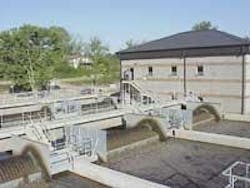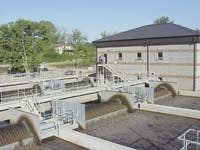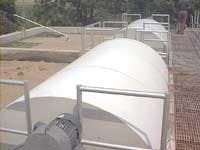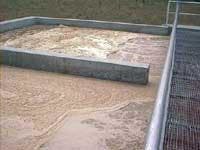Industrial Plant Uses New Zero Solids Discharge Technology
By Daniel R. Miklos and Robert D. Sproull
An activated sludge wastewater treatment plant (WWTP) at the Alpine Cheese Factory in Holmes County, OH, is so efficient that no sludge needs to be wasted out of the plant. The plant is devoid of sludge thickening and dewatering equipment, as well as sludge lagoons and sludge drying beds. For the first year after the WWTP became operational in 1999, the plant did not need to dispose of any sludge. Since then the monthly disposal rate has been minimal, due to increased loading rates.
The plant's Interchange Activated Sludge (IAS) treatment system primarily consists of two activated sludge reactor (oxidation) tanks operating in series, a clarifier, and a bystream sludge bioreactor tank. The interchange of flow between the oxidation tanks and the bioreactor tank causes the activated sludge to be restructured and recycled until all excess material is completely broken down and degraded.
Despite producing a high-strength wastewater stream, the zero solids discharge process allows the plant to achieve a high-quality effluent while using significantly less power to operate. Biochemical oxygen demand (BOD) from the final clarifier averages a mere 4 mg/L, greatly exceeding state requirements.
Treatment Process
Aerobic bacteria (activated sludge) first feed on the wastewater material in the Vertical Loop Reactor (VLR) oxidation tanks, where air is continuously added to keep the bacteria thriving. The VLR tanks, manufactured by USFilter's Envirex Products, are so named because the tanks are in the shape of a vertical looped racetrack, which allows fluid to flow in a circular motion. Air is injected into the bottom of the tank through course-bubble diffusers and rises through the tank's hollow center, where it mixes with the wastewater and flows around the track. This increases the contact time between the water and air, an important factor in the treatment process.
Each VLR tank at the Alpine Cheese Factory is 48 feet long and 20 feet wide, with a liquid depth of 15 1/2 feet and a volume of 100,000 gallons. At the surface, each tank has a 10-horsepower disc aerator assembly with 16 aeration discs. In the lower compartment, each tank has 20 coarse-bubble diffusers rated for a maximum airflow rate of 200 scfm.
After the BOD and ammonia have been oxidized in the VLR tanks, the liquid passes into a 20-foot diameter clarifier where the solids (sludge) fall to the bottom and the clear effluent is decanted off the top. The effluent is then disinfected, tested and released downstream.
In a conventional activated sludge treatment system, a portion of the sludge that settles to the bottom of the clarifier is returned to the oxidation tanks for repopulating the bacteria as Return Activated Sludge. Leftover sludge is then disposed of as Waste Activated Sludge (WAS).
At the Alpine Cheese WWTP, a portion of the activated sludge is pumped to a bystream sludge bioreactor, where the biosolids in the sludge are converted from an aerobic-dominant population to a facultative-dominant (non-aerobic) population. Aerobic bacteria are selectively destroyed while enabling the lower yield facultative bacteria to break down and use the remains of the aerobes and their byproducts in the bystream bioreactor. The facultative bacteria provide for a much lower growth rate while being further broken down in the alternating environments of the aeration tanks and IAS reactor.
In Alpine Cheese's treatment system, the biosolids flow stream that is carried from the activated sludge process to the 20,000-gallon tank bystream bioreactor is called Interchange Activated Sludge (IAS). The IAS flow rate varies somewhat, but no WAS is produced.
The IAS flow rate is equal to or less than what the expected WAS flow rate would be, and is extremely important to the overall system's successful operation. If the flow rate is too high, the residence time in the bystream bioreactor will be too short, resulting in fewer aerobes being broken down by facultative bacteria. And if the flow rate is too low, aerobic byproducts will build up in the aeration tanks. Hydraulic detention time in the bystream bioreactor ranges from five to 15 days.
For this process to be effective, two VLR tanks are used in series. The first VLR tank operates under aerated anoxic conditions, with its oxygen delivery rate constantly kept below the oxygen demand. The second tank operates with more oxygen delivery, with dissolved oxygen (DO) levels kept near or above 2 mg/L. The alternating DO environments and the strong upfront anoxic conditions optimize biomass-settling performance.
Performance results
Alpine Cheese's treatment system was designed for an influent flow of 25,000 gallons per day (gpd), BOD of 3,000 mg/L, total suspended solids (TSS) of 3,000 mg/L, and nitrogen level of 180 mg/L – a fairly strong wastewater flow. However, even though the plant is operating at over 50% above its design flow (i.e., at an average of 39,000 gpd), the treated effluent surpasses state requirements, typically measuring BOD of 4 mg/L, suspended solids of 12 mg/L, and total nitrogen removal.
As stated earlier, no sludge was hauled from the plant during the first year of operation. Since then, the plant has only hauled on average one truckload of sludge per month. This operational adjustment to the biological population was due to the excess load (39,000 gpd) being handled. By comparison, a conventional WAS treatment plant of this size would produce 500 pounds of waste sludge daily. On an annual basis, the plant would need to haul more than 1 million gallons of sludge, at concentrations of 2 1/2%. Instead, in using the IAS system, the plant has only hauled away approximately 50,000 gallons per year.
By properly balancing the interchange of bacteria with air delivery, the plant has been able to reduce the BOD very efficiently in terms of power costs, as the system uses approximately 0.29 kW per pound of BOD removed. A conventional activated sludge process typically uses double this amount.
Since the new plant has been in operation, Alpine Cheese has increased its cheese production and, consequently, its wastewater flow. The plant now treats an average of over 40,000 gpd. Despite high load conditions, the plant only uses 60% of its aerated horsepower. However, the plant continues to meet state criteria for effluent, while discharging solids at a rate equivalent to a sludge yield of only 0.04 lbs TSS/lbs BOD.
NOTE: USFilter's Envirex Products recently acquired the IAS technology used at the Alpine Cheese Factory's WWTP. USFilter will continue to develop the process while marketing it as the Cannibal™ process. This technology can also be used for municipal wastewater applications.
About the Authors: Daniel R. (Dan) Miklos is president of ATS Engineering, a company specializing in engineering, troubleshooting assistance, and management for the design and operation of water and wastewater facilities. He has a B.S. degree in Conservation from Kent State University in Kent, OH, and a M.A. degree in Environmental Systems from the University of Waterloo in Waterloo, Ontario. Robert D. (Bob) Sproull is manager of biological processes at USFilter's Envirex Products. A registered Professional Engineer, he has almost 20 years of experience in developing, marketing and selling wastewater treatment processes and equipment.



